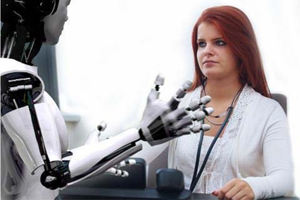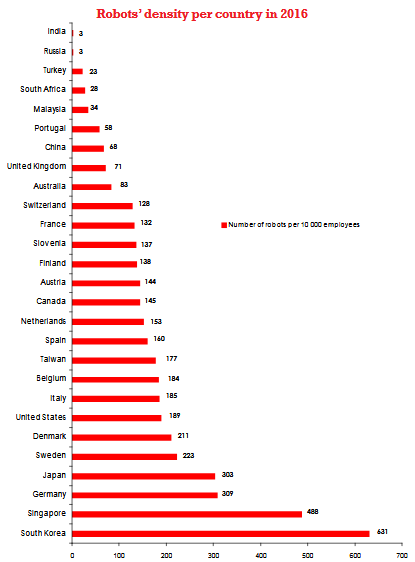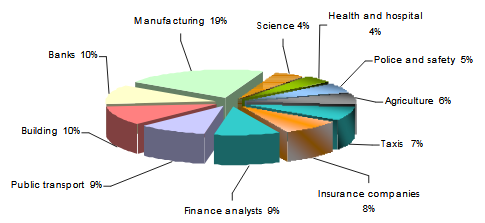The employment market: will robots take over?
These sophisticated machines that carry out most complicated and unexpected tasks are setting foot on insurance companies in remarkable fashion.
Robotization and its effect on employment
 |
According to the United Nations’ Conference on Trade and Development (UNCTAD), there are currently two million robots, mainly used in the automotive, electronics and electrical industries. Germany, United States and Japan are the countries that use these machines more than any other country.
Technological breakthroughs are not always an advantage, with so many drawbacks being noticed at the level of job losses. For the Organization of Economic Cooperation and Development (OECD), the take-off of robotics and artificial intelligence constitutes a direct threat for 14% of the jobs in the 35 member States of the organization. Robotization is to be behind the shedding of 66 million jobs during the upcoming decade.
No area in the world will be spared, with the trend knocking even on the doors of developing countries. The latter, thanks to imported equipment and tools, are starting to sense the impact as foreign manufacturers there began replacing local labor by machines.
In Ethiopia, for instance, Chinese companies are using robots to carry out some works. In Côte d’Ivoire, Abidjan harbor is undergoing automation with serious implications on dockers who risk to be replaced in thousands by automatons. In the Middle East, the United Arab Emirates are planning to replace a quarter of their law enforcement officers by androids.
Employment and industrial robotization: most automated countries
The density of the robots used per 10 000 staff members is used as a comparative tool. In the manufacturing industries, this density reached 74 robots worldwide in 2016 versus 66 in 2015. In other words, 74 were cohabitating with 10 000 employees in 2016 whereas in 2015 there were 66 robots per 10 000 workers. This stands as a clear illustration of corporate growing automation. This phenomenon tends to develop rapidly to reach more than 3 million androids by 2020.
Robot density is normally considerable in some areas with high industrial activity. It is in Asia, and more precisely, in South Korea, Singapore and Japan that robot density is highest.
| Average per region | Robots’density * |
|---|---|
| World average | 74 |
| Europe | 99 |
| Americas | 84 |
| Asia | 63 |
* Number of robots per 10 000 employees, 2016 figures
Source: World Robot Statistics 2017, International Federation of Robotics (IFR)

Main sectors under the threat of robotization
In the near future, automation is likely to affect 70% of all sectors without exception:

* Survey conducted by the British company ARM in partnership with Northstar Research Partners
Robotization and its effect on employment: threatened profiles
Several kinds of jobs will be directly affected by growing automation. The most exposed ones are:
Truck drivers, machine operators
In the next ten years, the advent of driverless trucks on American and European road networks will drive several million truck drivers out of business.
Construction workers
The first automated mason was born in Australia. Hadrian X is capable of climbing the walls of a building at the speed of 1 000 bricks per hour. It will be on the market as of 2019 at the price of 1.5 million USD.
A semi-automated mason is twice or three times as productive as a human being. Bulldozers and cranes will also become autonomous.
Sellers
With the advent of electronic sale, the human factor is more and more excluded from the commercial circuit. In supermarkets and malls, sellers and cashiers are being gradually replaced by electronic pay points.
Law enforcement officers
A robotized policeman, Reem, has been in office for several months in the emirate of Dubai. By 2030, a quarter of law enforcement officers in the city will be replaced by machines. Reem robots come with the price tag of 217 000 USD in their basic version.
Legal consultants
According to a survey conducted by Deloitte consultancy firm, 39% of jobs in legal departments will be automated by 2020. The job of librarians are prone to automation.
Medical staff
Robodocs are already operational. Watson, the medical robot designed by IBM, is already in business with medical teams endeavoring to detect and treat cancer. Robots will soon be able to take part actively in diagnostics and in surgeries.
Ubo, a robot designed to provide domestic assistance to elderly or dependent people, is now a real personal nurse, coming at the price of 1200 USD. This French innovation will be available for sale in the course of 2018.
Virtual accountants
Thanks to artificial intelligence and to “Machine Learning”, machines are now capable of preparing accounting statements, calculating profitability, measuring stocks,…
Drafters
Back office jobs such as that of editors will gradually be phased out, with machines stepping into the drafting of texts and reports.
